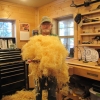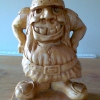It has always intrigued me that when you carve something, you start and end with the same amount of wood.
It's true - let me show you!

| 01 September 2018 22:13
Chris, I do love this project. I don't know how old the original is, but it has a gargoyle type influence. I find it very interesting. Definitely a great project! Thanks for sharing. By the way, you carve a lot faster than I do. ;)

| 29 August 2016 14:58
One of my favorite things about your videos is how you demonstratie your relationship to the wood work with. You clearly have a lot of love and reverence, not just for the end, but for the wood and the entire process. Thank you.

| 09 February 2014 21:05
Chris, loved your comments on the wood that is removed. It reflects what I took away from the entire series of lessons on this project and what you have emphasized in other projects. Having done a few "in the round" projects now, I have a) recognized my anxiety of taking wood off in the beginning and b) gained confidence by watching you "approach" the form. I see you constantly approaching the form, creeping up on it, balancing the form with other elements of the sculpture before you attend to details (and then it is done with deliberation and sharpness). I think I beat myself up too much in the beginning, thinking I "should" have all the details nailed down as I go, rather than the organic (and fun) process of the development as it happens, the approach to the shape. My envy comes from your mastery of the tools... someday.... (grin). The second thing I keep taking away from your awesome carvings is your comments about "making it look real, believable." The detail in design and execution of the feet on the bevel is a perfect example. That kind of detail is priceless and sets the carving on a whole new level of WOW. P.S. One of my favorite things about carving is wading through the chips on the floor. Other than a fire hazard, I would never sweep them up!

| 31 July 2013 10:08
Thanks Chris. I appreciate your reassurance that for me as a beginner its a sensible thing to do.
I will probably make models before starting for some time to come!

| 30 July 2013 14:17
David - That's a great question! On this website I'm trying to carve projects in different ways, to give you lots of options: in this case I went from photo to drawing one side, to carving; in the Merlin and Bat, I have worked with 2 drawings - both good ways of proceeding. However, the principle you want to follow is: before you start ANY carving, you need to have enough information; so you feel confident, can visualise where you want to remove wood and so on. In this case, I felt I did. For you, though, you wouldn't have had that confidence. So, yes, you'd need to work it out more and, certainly a model of either the whole or the difficult parts would be what you'd need. A lot of new carvers don't appreciate the value of a model when you have a complicated 3D subject - it's not 'cheating' any more than a drawing is cheating; and it's only a way of getting you into the wood without making a big mistake; you then can let your carving and eye take over. Beginners also think it makes the whole project longer but, actually, I've always find that I save time in the long run with an accurate, even if undetailed, model. Sorry, a long reply, but helpful I hope!

| 27 July 2013 13:39
As I watched the videos I was aware of the feeling that I would want to have a model to refer to.
I'm very 'unconfident' that I could have carved the front and back curvatures, beak and tail for example, without one - or at least something to measure from, and use a scale if needed.
I notice that you only use a drawing from the side, and a photograph. Did you ever think about a model for this Chris, or is this something you prefer to do by eye and maybe let things develop as you work?

| 08 October 2012 23:20
I am doing my best to learn how to carve birds. Feathers have been a real problem for me. Detailing 2 has cleared up a lot of my barriers. Of course all the lessons are super and appreciated.

| 27 September 2012 10:30
Richard - Working across end grain is always harder on the cutting edges than anywhere else, except perhaps a hard knot or something, so, yes, they do need a bit more TLC!

| 26 September 2012 13:55
Great carving Chris! Watched the whole project from start to finish on my day off! Wonderful technique and delievery as always. Alot of end grain to work into especially around the feet area, do you find that your stropping more when these areas are wored or is it no more than normal? Love the feathers.